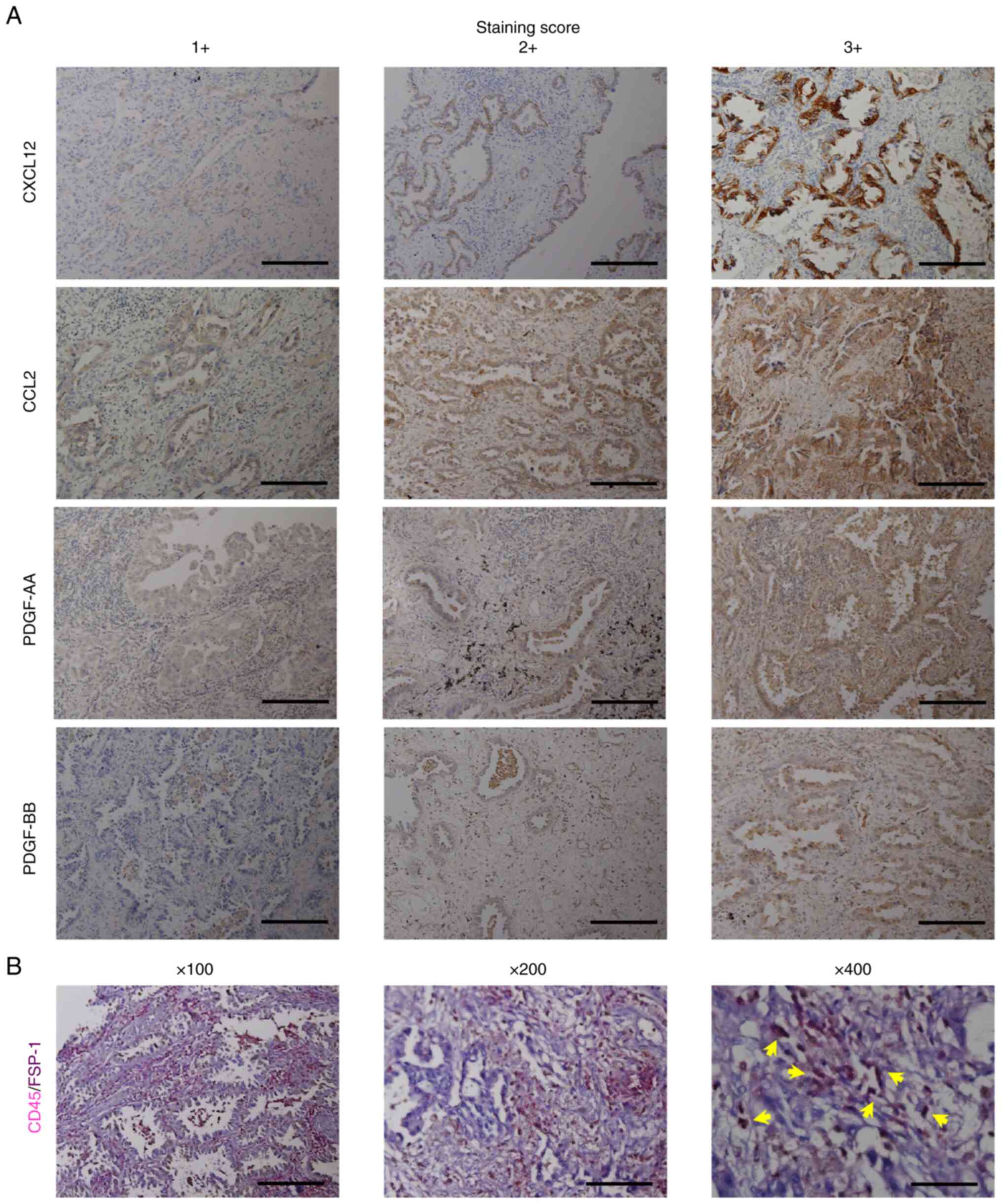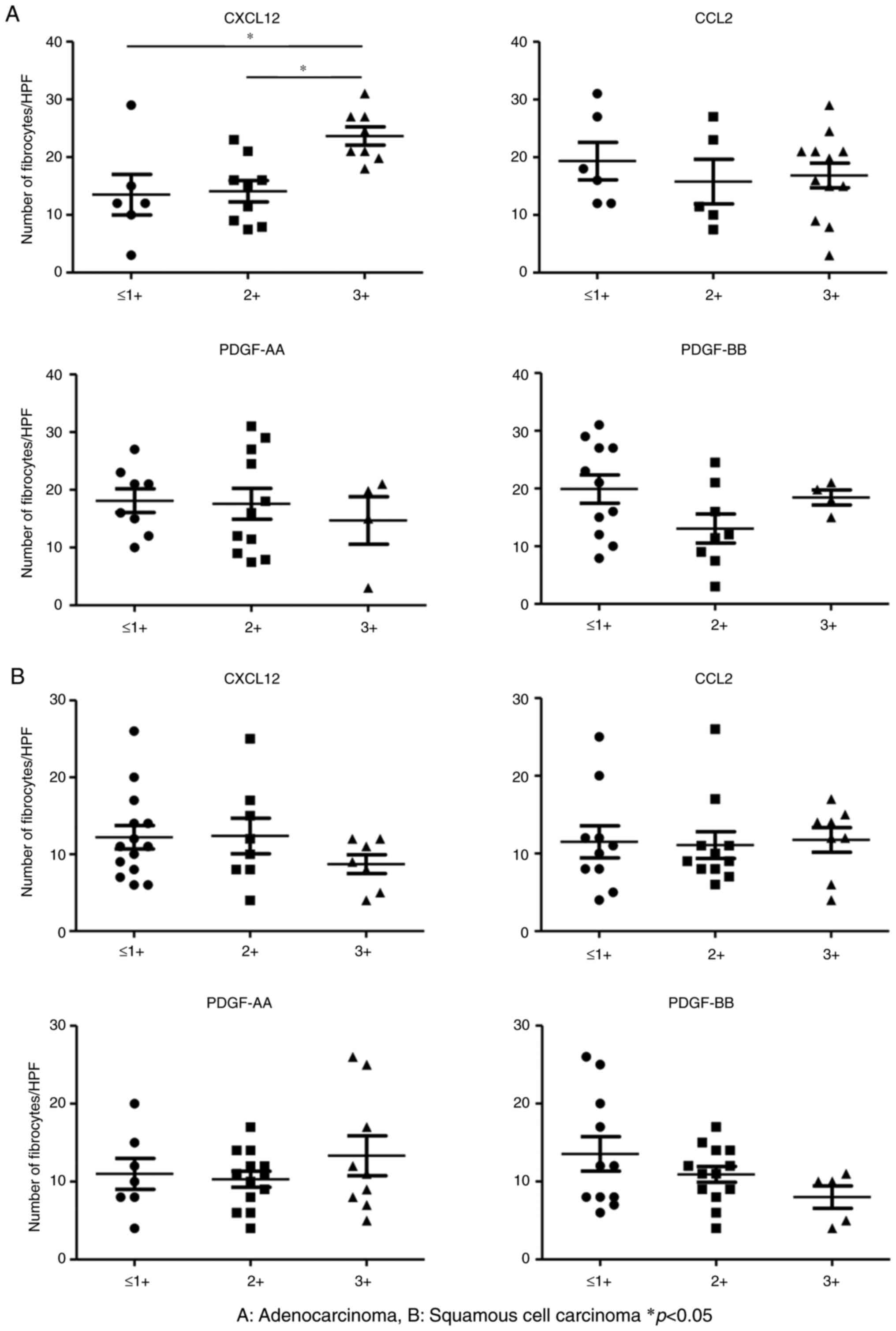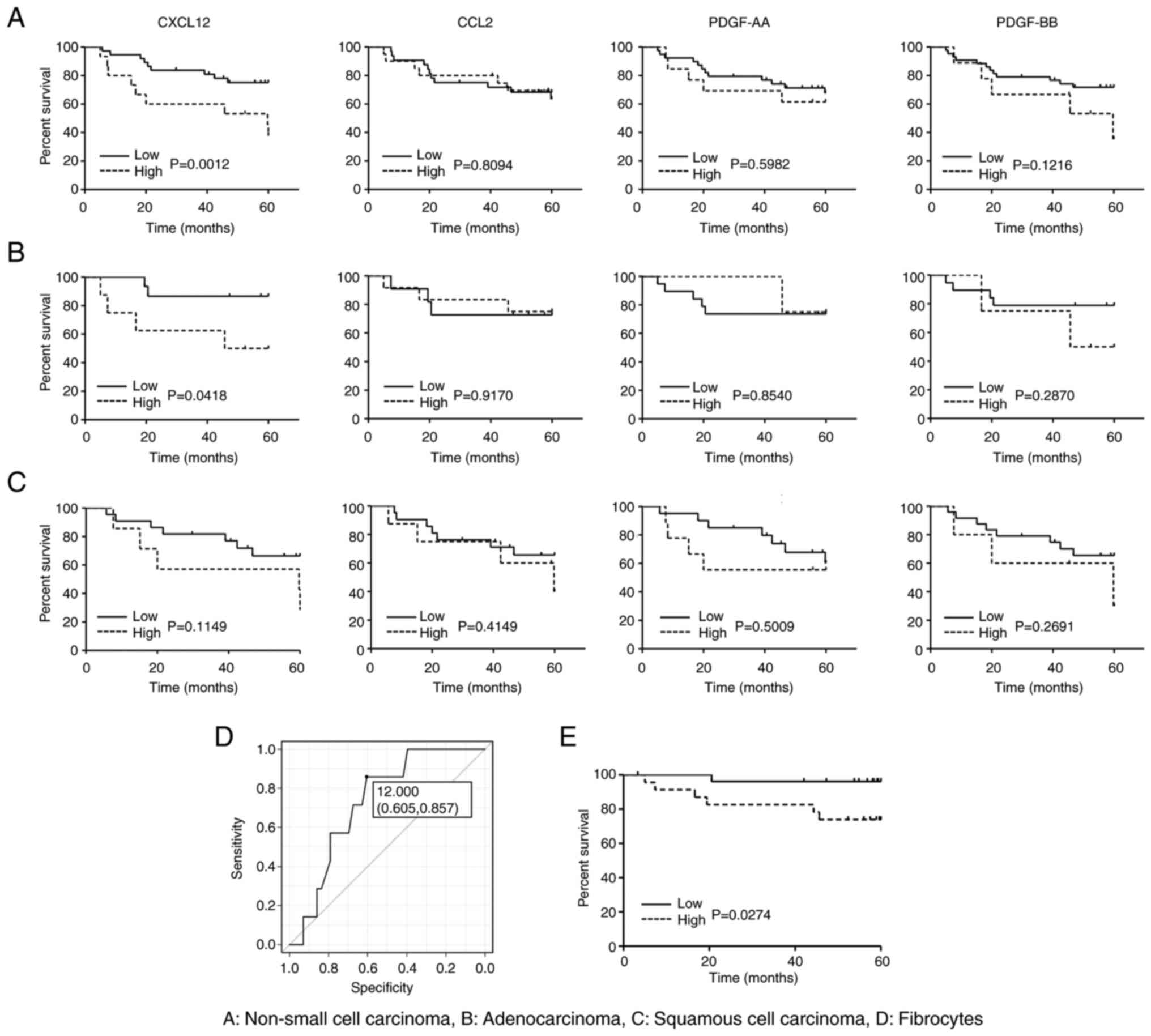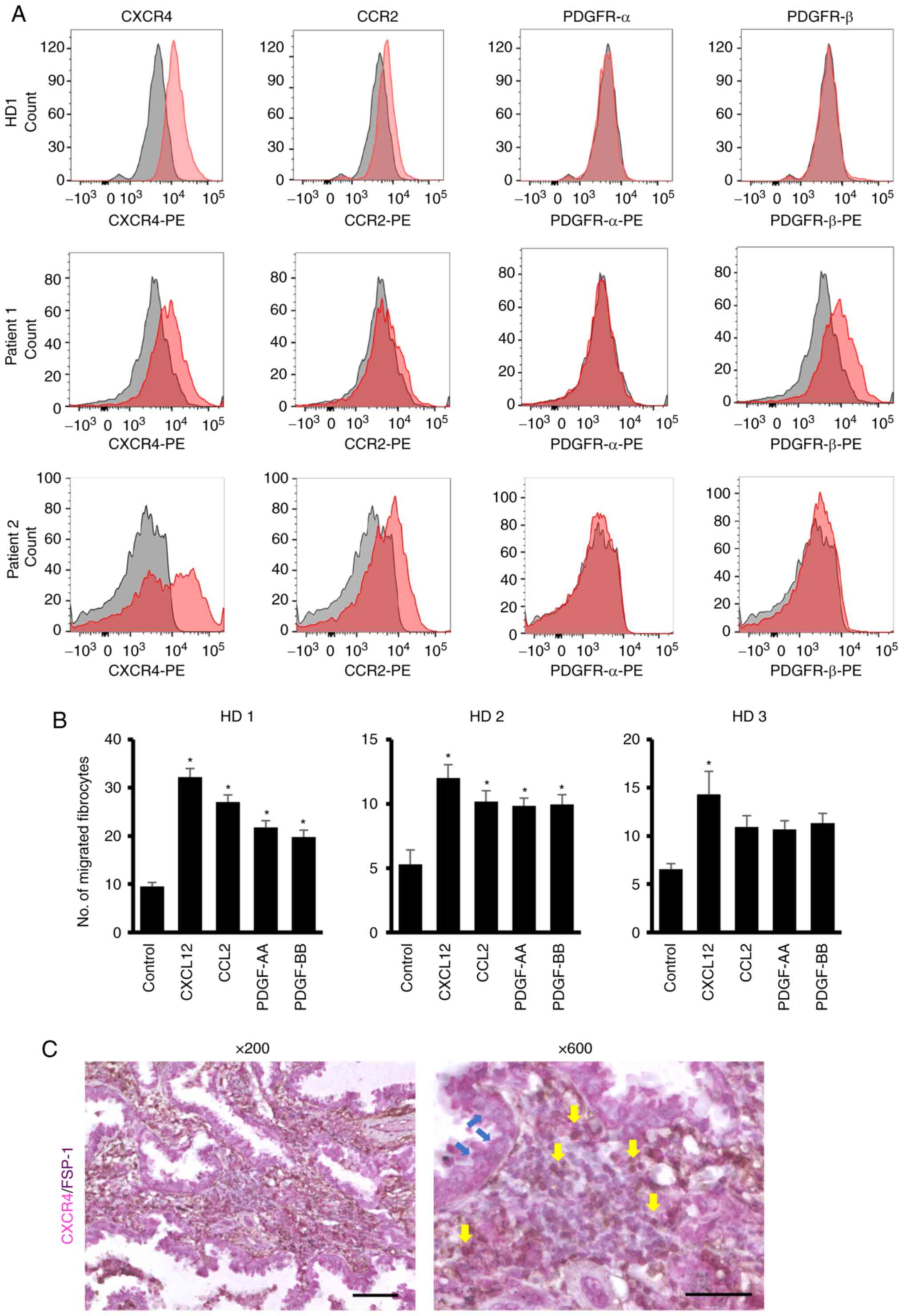|
1
|
Reilkoff RA, Bucala R and Herzog EL:
Fibrocytes: Emerging effector cells in chronic inflammation. Nat
Rev Immunol. 11:427–435. 2011. View
Article : Google Scholar : PubMed/NCBI
|
|
2
|
Bucala R: Fibrocytes at 20 years. Mol Med.
21 (Suppl 1):S3–S5. 2015. View Article : Google Scholar : PubMed/NCBI
|
|
3
|
Abe R, Donnelly SC, Peng T, Bucala R and
Metz CN: Peripheral blood fibrocytes: Differentiation pathway and
migration to wound sites. J Immunol. 166:7556–7562. 2001.
View Article : Google Scholar : PubMed/NCBI
|
|
4
|
Pilling D, Fan T, Huang D, Kaul B and
Gomer RH: Identification of markers that distinguish
monocyte-derived fibrocytes from monocytes, macrophages, and
fibroblasts. PLoS One. 4:e74752009. View Article : Google Scholar : PubMed/NCBI
|
|
5
|
Hashimoto N, Jin H, Liu T, Chensue SW and
Phan SH: Bone marrow-derived progenitor cells in pulmonary
fibrosis. J Clin Invest. 113:243–252. 2004. View Article : Google Scholar : PubMed/NCBI
|
|
6
|
Phillips RJ, Burdick MD, Hong K, Lutz MA,
Murray LA, Xue YY, Belperio JA, Keane MP and Strieter RM:
Circulating fibrocytes traffic to the lungs in response to CXCL12
and mediate fibrosis. J Clin Invest. 114:438–446. 2004. View Article : Google Scholar : PubMed/NCBI
|
|
7
|
Dupin I, Contin-Bordes C and Berger P:
Fibrocytes in asthma and chronic obstructive pulmonary disease:
Variations on the same theme. Am J Respir Cell Mol Biol.
58:288–298. 2018. View Article : Google Scholar : PubMed/NCBI
|
|
8
|
Sakai N, Wada T, Yokoyama H, Lipp M, Ueha
S, Matsushima K and Kaneko S: Secondary lymphoid tissue chemokine
(SLC/CCL21)/CCR7 signaling regulates fibrocytes in renal fibrosis.
Proc Natl Acad Sci USA. 103:14098–14103. 2006. View Article : Google Scholar : PubMed/NCBI
|
|
9
|
Kisseleva T, Uchinami H, Feirt N,
Quintana-Bustamante O, Segovia JC, Schwabe RF and Brenner DA: Bone
marrow-derived fibrocytes participate in pathogenesis of liver
fibrosis. J Hepatol. 45:429–438. 2006. View Article : Google Scholar : PubMed/NCBI
|
|
10
|
Suster S and Fisher C: Immunoreactivity
for the human hematopoietic progenitor cell antigen (CD34) in
lipomatous tumors. Am J Surg Pathol. 21:195–200. 1997. View Article : Google Scholar : PubMed/NCBI
|
|
11
|
Barth PJ, Ebrahimsade S, Hellinger A, Moll
R and Ramaswamy A: CD34+ fibrocytes in neoplastic and inflammatory
pancreatic lesions. Virchows Arch. 440:128–133. 2002. View Article : Google Scholar : PubMed/NCBI
|
|
12
|
Hartlapp I, Abe R, Saeed RW, Peng T,
Voelter W, Bucala R and Metz CN: Fibrocytes induce an angiogenic
phenotype in cultured endothelial cells and promote angiogenesis in
vivo. FASEB J. 15:2215–2224. 2001. View Article : Google Scholar : PubMed/NCBI
|
|
13
|
Sato S, Shinohara S, Hayashi S, Morizumi
S, Abe S, Okazaki H, Chen Y, Goto H, Aono Y, Ogawa H, et al:
Anti-fibrotic efficacy of nintedanib in pulmonary fibrosis via the
inhibition of fibrocyte activity. Respir Res. 18:1722017.
View Article : Google Scholar : PubMed/NCBI
|
|
14
|
Abe S, Sato S, Aono Y, Azuma M, Kishi M,
Koyama K, Takahashi N, Kagawa K, Kawano H and Nishioka Y:
Functional analysis of human fibrocytes derived from monocytes
reveals their profibrotic phenotype through paracrine effects. J
Med Invest. 67:102–112. 2020. View Article : Google Scholar : PubMed/NCBI
|
|
15
|
Mitsuhashi A, Goto H, Saijo A, Trung VT,
Aono Y, Ogino H, Kuramoto T, Tabata S, Uehara H, Izumi K, et al:
Fibrocyte-like cells mediate acquired resistance to anti-angiogenic
therapy with bevacizumab. Nat Commun. 6:87922015. View Article : Google Scholar : PubMed/NCBI
|
|
16
|
Moore BB, Murray L, Das A, Wilke CA,
Herrygers AB and Toews GB: The role of CCL12 in the recruitment of
fibrocytes and lung fibrosis. Am J Respir Cell Mol Biol.
35:175–181. 2006. View Article : Google Scholar : PubMed/NCBI
|
|
17
|
Aono Y, Kishi M, Yokota Y, Azuma M,
Kinoshita K, Takezaki A, Sato S, Kawano H, Kishi J, Goto H, et al:
Role of platelet-derived growth factor/platelet-derived growth
factor receptor axis in the trafficking of circulating fibrocytes
in pulmonary fibrosis. Am J Respir Cell Mol Biol. 51:793–801. 2014.
View Article : Google Scholar : PubMed/NCBI
|
|
18
|
Isgrò M, Bianchetti L, Marini MA, Bellini
A, Schmidt M and Mattoli S: The C-C motif chemokine ligands CCL5,
CCL11, and CCL24 induce the migration of circulating fibrocytes
from patients with severe asthma. Mucosal Immunol. 6:718–727. 2013.
View Article : Google Scholar : PubMed/NCBI
|
|
19
|
Saijo A, Goto H, Nakano M, Mitsuhashi A,
Aono Y, Hanibuchi M, Ogawa H, Uehara H, Kondo K and Nishioka Y:
Bone marrow-derived fibrocytes promote stem cell-like properties of
lung cancer cells. Cancer Lett. 421:17–27. 2018. View Article : Google Scholar : PubMed/NCBI
|
|
20
|
Roife D, Fleming JB and Gomer RH:
Fibrocytes in the tumor microenvironment. Adv Exp Med Biol.
1224:79–85. 2020. View Article : Google Scholar : PubMed/NCBI
|
|
21
|
Goto H and Nishioka Y: Fibrocytes: A novel
stromal cells to regulate resistance to anti-angiogenic therapy and
cancer progression. Int J Mol Sci. 19:982017. View Article : Google Scholar : PubMed/NCBI
|
|
22
|
Suzuki M, Mohamed S, Nakajima T, Kubo R,
Tian L, Fujiwara T, Suzuki H, Nagato K, Chiyo M, Motohashi S, et
al: Aberrant methylation of CXCL12 in non-small cell lung cancer is
associated with an unfavorable prognosis. Int J Oncol. 33:113–119.
2008.PubMed/NCBI
|
|
23
|
Wagner PL, Hyjek E, Vazquez MF, Meherally
D, Liu YF, Chadwick PA, Rengifo T, Sica GL, Port JL, Lee PC, et al:
CXCL12 and CXCR4 in adenocarcinoma of the lung: Association with
metastasis and survival. J Thorac Cardiovasc Surg. 137:615–621.
2009. View Article : Google Scholar : PubMed/NCBI
|
|
24
|
Sterlacci W, Saker S, Huber B, Fiegl M and
Tzankov A: Expression of the CXCR4 ligand SDF-1/CXCL12 is
prognostically important for adenocarcinoma and large cell
carcinoma of the lung. Virchows Arch. 468:463–471. 2016. View Article : Google Scholar : PubMed/NCBI
|
|
25
|
Katsura M, Shoji F, Okamoto T, Shimamatsu
S, Hirai F, Toyokawa G, Morodomi Y, Tagawa T, Oda Y and Maehara Y:
Correlation between CXCR4/CXCR7/CXCL12 chemokine axis expression
and prognosis in lymph-node-positive lung cancer patients. Cancer
Sci. 109:154–165. 2018. View Article : Google Scholar : PubMed/NCBI
|
|
26
|
Donnem T, Al-Saad S, Al-Shibli K, Andersen
S, Busund LT and Bremnes RM: Prognostic impact of platelet-derived
growth factors in non-small cell lung cancer tumor and stromal
cells. J Thorac Oncol. 3:963–970. 2008. View Article : Google Scholar : PubMed/NCBI
|
|
27
|
Donnem T, Al-Saad S, Al-Shibli K, Busund
LT and Bremnes RM: Co-expression of PDGF-B and VEGFR-3 strongly
correlates with lymph node metastasis and poor survival in
non-small-cell lung cancer. Ann Oncol. 21:223–231. 2010. View Article : Google Scholar : PubMed/NCBI
|
|
28
|
Liu J, Liu C, Qiu L, Li J, Zhang P and Sun
Y: Overexpression of both platelet-derived growth factor-BB and
vascular endothelial growth factor-C and its association with
lymphangiogenesis in primary human non-small cell lung cancer.
Diagn Pathol. 9:1282014. View Article : Google Scholar : PubMed/NCBI
|
|
29
|
Zhang XW, Qin X, Qin CY, Yin YL, Chen Y
and Zhu HL: Expression of monocyte chemoattractant protein-1 and CC
chemokine receptor 2 in non-small cell lung cancer and its
significance. Cancer Immunol Immunother. 62:563–570. 2013.
View Article : Google Scholar : PubMed/NCBI
|
|
30
|
Li L, Liu YD, Zhan YT, Zhu YH, Li Y, Xie D
and Guan XY: High levels of CCL2 or CCL4 in the tumor
microenvironment predict unfavorable survival in lung
adenocarcinoma. Thorac Cancer. 9:775–784. 2018. View Article : Google Scholar : PubMed/NCBI
|
|
31
|
Wald O, Izhar U, Amir G, Kirshberg S,
Shlomai Z, Zamir G, Peled A and Shapira OM: Interaction between
neoplastic cells and cancer-associated fibroblasts through the
CXCL12/CXCR4 axis: Role in non-small cell lung cancer tumor
proliferation. J Thorac Cardiovasc Surg. 141:1503–1512. 2011.
View Article : Google Scholar : PubMed/NCBI
|
|
32
|
Henrot P, Beaufils F, Thumerel M, Eyraud
E, Boudoussier A, Begueret H, Maurat E, Girodet PO, Marthan R,
Berger P, et al: Circulating fibrocytes as a new tool to predict
lung cancer progression after surgery? Eur Respir J.
58:21012212021. View Article : Google Scholar : PubMed/NCBI
|
|
33
|
Dai X, Mao Z, Huang J, Xie S and Zhang H:
The CXCL12/CXCR4 autocrine loop increases the metastatic potential
of non-small cell lung cancer in vitro. Oncol Lett.
5:277–282. 2013. View Article : Google Scholar : PubMed/NCBI
|


















